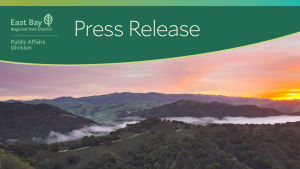NatureCheck Study Creates Baseline for Measuring Wildlife Health in the East Bay
The East Bay Regional Park District, in cooperation with other land management agencies in Alameda and Contra Costa Counties, has finished its inaugural report, “NatureCheck: A report on the health of wildlife in the East Bay.” The Park District partnered with California State Parks, East Bay Municipal Utility District, Contra Costa Water District, and San Francisco Public Utilities Commission to assess the ecological health of 225,000 acres of public land in the East Bay that found that, generally, wildlife is in fair condition, with most species showing stable trends. There is reason to be cautious, however, as the data does not yet include the last two years of drought.
The first such ecological health assessment of its kind for the East Bay region, the NatureCheck report assesses the conditions and trends of indicator species within East Bay Stewardship Network (Network) lands, including fish, amphibians, birds, and mammals, and establishes a baseline to identify changes over time. Indicator species are species that are readily measured and provide correlation to specific habitat niches and health.
The assessment is especially important given the stressors the environment faces right now with climate change, invasive species, and increasing urbanization.
The East Bay Stewardship Network includes California State Parks, EBMUD, CCWD, SFPUC, and EBRPD, with combined management of close to 225,000 acres totaling 25 percent of lands in Alameda and Contra Costa counties.

The Network partners have collaborated since 2018 to share data on wildlife indicators, consult with experts in the field to develop workable metrics, and analyze the overall health of wildlife.
“We have all sorts of metrics for evaluating human health, such as blood pressure, heart rate, and cholesterol,” said Park District Chief of Stewardship, Matt Graul. “The East Bay Stewardship Network partners created the NatureCheck report to assess and monitor overall ecological health.”
“The ability to understand and track changes will help us better manage parklands and wildlife habitat to support ecological integrity and resiliency,” added Graul.
Overall, the data shows East Bay wildlife are in fair condition and that most of the species are showing stable trends, including fish, bats, mesocarnivores, such as bobcats and foxes, and pumas. The Network is hopeful that its lands provide habitat corridors and connectivity that support populations of pumas and American badgers, species with large home ranges and low population densities. It is also heartening that although the data does not yet include the last two years of drought, the assessment shows that our native amphibians, including California red-legged frogs and California tiger salamanders, are in good condition.
There are still reasons to be cautious moving forward. The report shows that the condition of grassland birds is of significant concern and that golden eagles are likely experiencing high adult mortality. Also concerning is that some wildlife indicators show declining trends, including the California tiger salamander and grassland bird species. Native fish populations face increased stressors from climate change, and while the overall trend is steady, more work is needed to restore their native ecosystem and to provide connections from streams to the San Francisco Bay.
Additional data is needed on trends, distribution, and abundance of the California ground squirrel, a keystone species essential to the biodiversity of grasslands. Next, Network partners will combine future assessments of vegetation health with the latest information on wildlife indicators to provide a more robust picture of ecological health. Aligning data collection methods across agencies will provide more usable information that will strengthen this regional approach to supporting the health of East Bay habitats.You can read about these indicator species and NatureCheck results here.
Funding for the NatureCheck ecological health assessment of wildlife was provided by the Regional Parks Foundation and Marathon.







